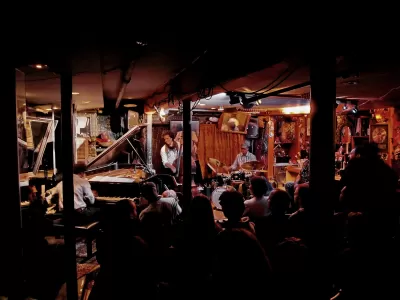A new real estate investment fund wants to help music venue owners buy their properties and stay in business as the pandemic and market forces decimate their earnings.

When the pandemic shut down live entertainment, music venues saw their revenues plummet as much as 90%, with many struggling to keep paying their bills. To help venues stay afloat, Dayna Frank, owner of First Avenue Music Hall in Minneapolis, worked with Grubb Properties CEO Clay Grubb to create "the Live Venue Recovery Fund, a pioneering program that provides eligible independent music operators with a 3 – 5 year roadmap toward purchasing their own venues." Rebecca Greenwald reports on the fund's efforts for Next City.
As renters, Frank believes, many venue owners are extremely vulnerable to "a growing affordability crisis and the whims of opportunistic landlords, and the looming threat of Live Nation’s growing influence and consolidation of the industry." The recovery fund aims to shift the balance of power and give venue operators a path to ownership. "Designed around an impact fund real estate model, the Live Venue Recovery Fund caps Grubb’s rate of return at 12%, after which any remaining returns are donated to the National Independent Venue Foundation, a nonprofit related to the National Independent Venue Association (NIVA), a trade association that was formed at the start of the pandemic."
"Rather than looking at the Live Venue Recovery Fund as an aggressive acquisition program," writes Greenwald, "Frank sees this as a resource and another option that venues have available to them as they navigate a challenging external environment."
FULL STORY: Will This Impact Fund Save America’s Music Venues?

Planetizen Federal Action Tracker
A weekly monitor of how Trump’s orders and actions are impacting planners and planning in America.

San Francisco's School District Spent $105M To Build Affordable Housing for Teachers — And That's Just the Beginning
SFUSD joins a growing list of school districts using their land holdings to address housing affordability challenges faced by their own employees.

The Tiny, Adorable $7,000 Car Turning Japan Onto EVs
The single seat Mibot charges from a regular plug as quickly as an iPad, and is about half the price of an average EV.

Seattle's Plan for Adopting Driverless Cars
Equity, safety, accessibility and affordability are front of mind as the city prepares for robotaxis and other autonomous vehicles.

As Trump Phases Out FEMA, Is It Time to Flee the Floodplains?
With less federal funding available for disaster relief efforts, the need to relocate at-risk communities is more urgent than ever.

With Protected Lanes, 460% More People Commute by Bike
For those needing more ammo, more data proving what we already knew is here.
Urban Design for Planners 1: Software Tools
This six-course series explores essential urban design concepts using open source software and equips planners with the tools they need to participate fully in the urban design process.
Planning for Universal Design
Learn the tools for implementing Universal Design in planning regulations.
Smith Gee Studio
City of Charlotte
City of Camden Redevelopment Agency
City of Astoria
Transportation Research & Education Center (TREC) at Portland State University
US High Speed Rail Association
City of Camden Redevelopment Agency
Municipality of Princeton (NJ)





























